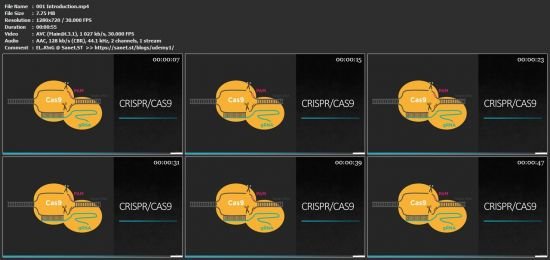Basics of CRISPR/Cas9 Technology

https://CourseMega.com
MP4 | Video: h264, 1280x720 | Audio: AAC, 44.1 KHz
Language: English | Size: 500 MB | Duration: 50m
Basics and the fundamentals of the CRISPR/Cas9, a master class for gene editing! from the expert in the field.
What you'll learn
Discover the promise of CRISPR in genome engineering
Distinguish 4 types of targeted nucleases available to precisely cut DNA
Compare somatic cell and germline gene editing techniques
Describe the basic mechanism that underlies the CRISPR/Cas9 genome engineering technology.
Discuss biological uses for a dead Cas9 (dCas9) protein
Evaluate CRISPR/Cas9 strategies for generating better mouse models
Formulate a complete strategy for performing fundamental genetic engineering experiments
Examine the process of making a precisely-defined, genetically modified mouse in six to eight months
Analyze CRISPR/Cas9 complications, including off-target events and founder mosaicism
And a lot more...
Requirements
Be desired to learn about CRISPR/Cas9, revolutionizing gene editing technology
Have at least basic knowledge of English language,
Have at least the basic knowledge of the genetics and the terms used in genetics.
Description
CRISPR/Cas9 is a gene-editing tool that can manipulate gene expression in plants, humans, and animals. CRISPR, or Clustered Regularly Interspaced Short Palindromic Repeats, are short sections of bacterial DNA containing repetitive base sequences. CRISPR plays a crucial role in the immune response of bacteria against foreign DNA. When a bacterium detects viral DNA, it produces two strands of short RNA called guide RNA, which then go on to form a complex with an endonuclease enzyme called Cas9 (CRISPR-associated protein 9).
This complex targets and cuts out the viral DNA rendering the virus disabled. The Cas9 nuclease will not bind to the DNA if the target sequence is not followed by the Protospacer Adjacent Motif, or PAM, which helps the enzyme distinguish between the bacterial DNA and the viral DNA target. The CRISPR/Cas9 system then has the ability to store this viral data so that it will be able to recognize and eliminate future viral threats.
This process can be done in a cell’s nucleus, in stem cells, embryos, and even extracellularly in a test tube. CRISPR/Cas9 is able to edge out other gene-editing techniques like TALEN and Zinc finger nucleases because it is the only technique that is highly efficient and precise, extremely customizable, and can target multiple genes at once.
The versatility of the CRISPR/Cas9 system and its ability to locate and alter specific genes can yield advancements in drug discovery, basic medical research, agriculture, and even the possibility of preventing genetic diseases, heart disease, and blood conditions in humans. One example is the possibility of creating a Malaria-resistant Mosquito, in which scientists were able to alter multiple genes in a type of mosquito that allows it to become resistant to Plasmodium falciparum, the parasite that causes Malaria.
